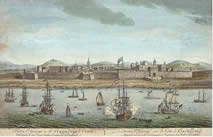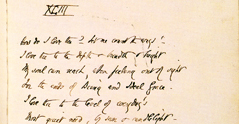EAST INDIA COMPANY FACTORY RECORDS
Sources from the British Library, London
Part 4: Fort St George (Madras), 1669-1758
History of Fort St George (Madras)
The East India Company arrived first at Surat, India in 1608 in the ship “Hector” commanded by William Hawkins and within a few years had established a permanent factory there. Surat was the port used by the textile manufacturers of Gujerat and was the most important centre for the overseas trade of the Mughal Empire. However the Portuguese already had trading arrangements with the Mughal authorities and supremacy on the seas and it would take several years for the English to gain control. A factory was eventually established at Surat in 1612 when the Portuguese fleet was defeated by the English.
On the other side of India the East India Company had since 1611 been based at Masulipatam on the Coromandel coast of India. By 1626 it had extended its activities further south and established a settlement at Armagon taking advantage of the cheapness of cloth there. However the new site had disadvantages and the Company accepted an invitation from the ruler of the district around Madraspatam to establish a factory there in 1640. The factory was called Fort St George and rapidly grew in importance as a centre for the Company’s trading activity in the east, replacing Bantam in 1682 as the headquarters of the eastern trade.
The textile industry in the main production areas of Coromandel, Gujarat and Bengal employed hundreds of thousands of skilled weavers, dyers and washers producing enormous quantities of muslins, chintzes, cotton and quilts which found a ready market in England. As early as 1620 50,000 pieces of chintz were imported and even as late as the 1750s Indian textiles accounted for sixty per cent of the total value of the Company’s sales in London.
In 1746 Madras was captured by the French and East India Company operations were transferred to Fort St David. Madras was eventually restored to the British in 1748.
The foundations for the success of the Fort St George (Madras) factory were laid by Thomas Pitt, President at Madras from 1698 to 1709. The letters and records offered here provide an excellent resource for the study of the eastern trade and the development of this important colonial city and port. The range of documents includes:
Correspondence with the Nabob of Golconda and copies of letters received mostly from Golconda and St Thomé, 1669-1677
- Letters from the Nabob of Golconda, Chenapelle Mirzah to the Governor of Fort St George and from the Governor to the Nabob Yecknam Caune
- Correspondence with the King of Zeilon
- Letters to the English captives in Golconda
- Letters from the Nabob of Golconda, Babah Ibrahim
- Letters in French from the Governor of St Thomé, Msr de la Hay to the Governor of Fort St George
Copies of letters received at Fort St George (Madras), 1676-1704
These were received from other factories such as Fort St David and Vizagapatam giving a mass of detail on the finances and running of these factories, experiences of those working there and negotiations with Nabobs. Also received were letters from ships’ captains. Included are:
- Letters from ships’captains c1695 to the Governor, Nathan Higginson giving details of voyages undertaken, sickness on board, attacks by enemy ships, goods carried on board, the arrival and departure of ships, bills of lading and invoices
- Letters from the factors at Fort St David, W Hatsell, Ralph Ingram and Thomas Constable reporting on attacks by the Nabob who stole cattle and children and negotiations with him, the strengthening of fortifications at the factory to prevent plundering and burning of villages by the Nabob, details of cloth sent to Fort St George, notes on customs fees paid
- Letters from the factors at Vizagapatam regarding the washing of cloth, “Europe goods”, trade carried out at Pullicherry, news on local dignitaries and negotiations with them, reports on the activities of the Dutch, reports of meetings and decisions of the factory members
- Detailed accounts of Fort St David, 1700
- Account by John Haynes, Governor of Fort St David of his experiences while taken prisoner by the Moors, 1700
- Details on the fighting around Vizagapatam with the local Nabob in 1700, including a report that the Dutch merchants had been robbed
- Translations of “perwannas” from Nabobs such as Ascar Cawn regarding negotiations with the English
- Translation of a “coute” granted by Raina Raja to Laurencia Pitt, Dutch Governor of the coast of Chormondell
Other letters received are:
-
Letters from other factories in India, including Ingeram, Ganjam, Vizagapatam, Fort St David, Maddapollam, Fort William, Tillichery, Anjengo, 1746 giving details of visits by local Nabobs, accounts of the factories, stores needed, dispatch of cloth to England and strengthening of fortifications. Annual letters from the factors at Fort St David report on the transactions for the year, including the number of bales of cloth sent to Fort St George and the increase and decrease of customs charges and expenses.
-
Letters from Fort St David, 1750 mostly concerning goods sent to Fort St George including silver, ” fanams” (gold coins) and “candies of doodoes”. Also included are details of medicine they have received, the arrival of ships, disposal of rice, goods sent to Fort St George and slaves arrived at the port.
-
Letters from the factories Fort Marlbro’, Fort St David, and Vizagapatam and from St Helena, 1753 giving dates of arrival and departure of ships, details of goods carried on the ships and of stocks of cloth held at the factories
Letters from the Governor at Fort St George (Madras) to other places in India, 1703-1705, 1752-1758
The letters were transcribed and typed for the court records. They were written to a variety of people:
- To the factors at Fort St David, Fort St William, Vizagapatam, Ingeram and Madapollam concerning goods sent, negotiations with local Nabobs, fighting with the French
- To the captains of ships giving instructions for their journeys and what cargoes they should carry
- To Supra Cargoes on board ships giving advice on which ports should be visited
- To the assay masters regarding the amount of copper used in the coinage
- To the military storekeepers asking for details of arms and ammunition held in the armoury
Correspondence with Native Princes and their officials, 1703-1705
- Letters from Native Princes to the Governor requesting favours for themselves and their friends
- Letters describing attacks on Princes by neighbouring Nabobs and requests for ammunition in order to retaliate
- Letters expressing thanks for gifts sent to the Native Princes including oranges and wooden spoons
- Lists of goods the Princes wished to purchase from the EIC including coffee, tobacco, almonds, raisins, vinegar, dates, saffron, walnuts
- Details of runaway slaves owned by the Princes
- Requests by Native Princes for elephants and silk worms in exchange for rice and “rock mummy”
Letters to the Court of Directors of the EIC, London, 1745-1746
These long and detailed letters from the Governor of Fort St George were transcribed and typed for the Court’s records. The information is divided into sub headings and contains a wealth of interesting details regarding the work of the factory of Fort St George and other factories in its vicinity.
- Details of sailings of ships from Fort St George
- Reports on ships sailing from Malacca to China being intercepted by Spanish ships
- Lists of goods from Europe
- Lists of goods being sent from one part of India to another including rice from Bengal, silver and broadcloth
- Details on goods sent by London such as guns, Madeira wine, copper and velvet
- Reports on goods bought by the factory to be sent to England such as salem cloth and “chang” or coloured cloth, giving the number of bales and reports on the weavers
- Expansion of trade to Persia
- Difficulties of trade in India owing to fighting among factions
- Proposals by Native Princes to settle other places in the name of the EIC
- Work on fortifications
- Reports on the factors, writers and officers with details of their allowances
- Factory accounts
- Reports on the west coast of India
- Reports on the activities of the French and other European countries in India
- Latest news on the war with the French
Other interesting items included are:
- Diary and Letter Book of Richard Mohun, 1676-1677 and an account of gold coined at Fort St George by Richard Mohun and Vincent Sayon, 1679
- Letter Book of Thomas Lucas while on a mission to Conjevaram, 1683 which includes instructions by the factors on preventing other countries trading or settling anywhere in the Sangania’s jurisdiction and letters from Lucas to the factors describing his journey to Conjevaram, his negotiations and travels in the area. In addition are some letters to the factors from the Portuguese.
- Proceedings in the Court of Judicature, 1678, 1693-1694 giving details of cases brought before the court, mostly consisting of complaints against merchants with relevant correspondence
The following extracts from the Factory Records will give just a feel for the range of topics covered:
G/19/40 Letter from the Governor of Fort St George to the Court of Directors, London, 15 February 1754/45 regarding investments:
“The new Nabob of Rajahmundrum has again this year as last attempted to force Timbers on the two Factories of Ingeram & Madapollam and for that purpose sent for their vackeels whom he imprisoned & abused till he had exorted a sum of money: no business could go forward at either of those places for some time the Merchants being obliged to abscond….”
G/19/41 Letter from the Governor at Fort St George to Mr Foss Wescott, Resident at Ingeram, 27 July 1752:
“…. Though the Nabob has permitted you to reside at the old Factory as formerly yet as you carry on your Business conveniently and are more secure at Nilla Pilla, we think it best you continue there till we see how Affairs are above. Chunda Saib and his Army have been defeated by Aneverdee Cawn who is now near Gingee, this Victory gave us reason to expect that the Province would be settled….”
G/19/43 Letter from the factors at Fort St David to the Governor at Fort St George, 1 February 1746:
“…. Your Honours will be pleased to observe, we have put on board Three Hundred and Ten Bales of Brown cloth, which we were Directed to do, from Fort St George, in case we had not white sufficient to compleat her Tonnage…. We have from the first of February last, sent to Madras Three Hundred & Seventeen Bales of last year’s Investment…. Captain Cooke petitioned for four hundred & Fifty Pagodas for his ships use which we have advanced him, and in the Packet comes his obligation for the same….”
The Factory Records of the East India Company for Fort St George (Madras) are an indispensable tool for researchers interested in the early trading networks in South East Asia. Parts 5 and 6 of this series will cover the records for Calcutta and Bombay.
|

|















